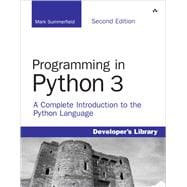Python 3 is the best version of the language yet: It is more powerful, convenient, consistent, and expressive than ever before. Now, leading Python programmer Mark Summerfield demonstrates how to write code that takes full advantage of Python 3’s features and idioms. Programming in Python 3, Second Edition, brings together all the knowledge you need to write any program, use any standard or third-party Python 3 library, and create new library modules of your own.
Summerfield draws on his many years of Python experience to share deep insights into Python 3 development you won’t find anywhere else. He begins by illuminating Python’s “beautiful heart”: the eight key elements of Python you need to write robust, high-performance programs. Building on these core elements, he introduces new topics designed to strengthen your practical expertise–one concept and hands-on example at a time. Coverage includes
-Developing in Python using procedural, object oriented, and functional programming paradigms
-Creating custom packages and modules
-Writing and reading binary, text, and XML files, including optional compression, random access, and text and XML parsing
-Leveraging advanced data types, collections, control structures, and functions
-Spreading program workloads across multiple processes and threads
-Programming SQL databases and key—value DBM files
-Debugging techniques–and using Test Driven Development to avoid bugs in the first place
-Utilizing Python’s regular expression mini-language and module
-Parsing techniques, including how to use the third-party PyParsing and PLY modules
-Building usable, efficient, GUI-based applications
-Advanced programming techniques, including generators, function and class decorators, context managers, descriptors, abstract base classes, metaclasses, coroutines, and more
Programming in Python 3, Second Edition, serves as both tutorial and language reference. It assumes some prior programming experience, and it is accompanied by extensive downloadable example code–all of it tested with Python 3 on Windows, Linux, and Mac OS X.
“…Fulfills the immediate market need for those developers seeking to learn this latest evolutionary version of the Python lineage in a succinct, well-written package.”–Mike Riley, Contributing Editor for Dr. Dobb’s
“Beyond the introduction to programming in Python 3 in the first chapter, if you progress through the first six chapters in sequence, you’ll be well on your way to taking off with using Python independently.”–James Pyles, Technical Writer and Author of the blog “A Million Chimpanzees”








